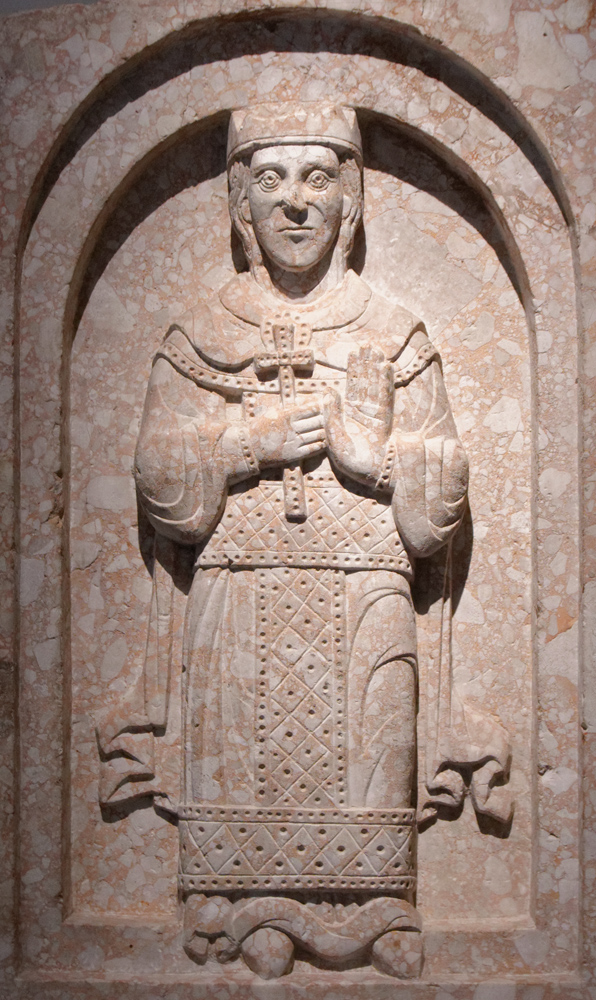In Orthodox icons, the saint holds a small cross in her right hand and sometimes a phial in her left, as at right. The hand cross is the usual symbol of martyrdom in Orthodox iconography. We also see it in the stone relief at right, originally from the Cathedral of St. Anastasia in Zadar, Croatia. The phial relates to the "medicine" gained for mankind in the Resurrection. ("Resurrection" is what the name Anastasia means in Greek.)1
In other western images she sometimes holds a flame in her hand, either in a bowl (example) or directly on the palm of the hand, as in two sculptures in the Benedictine convent in Zadar, Croatia.2 The flame refers to Anastasia of Sirmium's death by fire. Rarely, the flame will be on a torch (example).
The Anastasia of the Golden Legend had been forced into a marriage that she would not consummate. Nevertheless, the second picture at right dresses her as a matron, in veil and wimple, rather than bare-headed like a virgin, as does this relief in the tympanum of the cathedral's west portal. She is similarly dressed in a 14th-century Book of Hours (third picture at right) and in a late 13th century French illumination Later images in the convent collection have her bare-headed with a book and palm branch.3
There is also a St. Anastasia the Patrician, a Byzantine lady-in-waiting of the 6th century who fled the court to live as a hermit in the desert. See Brock and Harvey.
Prepared in 2014 by Richard Stracke, Emeritus Professor of English, Augusta University, revised 2015-07-26.
HOME PAGE
Icon of St. Anastasia, 14th century (See the description page.)

Relief in the Convent of St. Mary, Zadar, Croatia (See the description page.)

St. Anastasia with a book and palm branch in a 13th-century Book of Hours (See description page)
ATTRIBUTES
- East: Hand cross, sometimes a vase.
- West: Flames on hand or in a bowl on the hand, palm branch, sometimes a book.
IMAGES IN PUBLICATIONS
- 1326: Frontal of a reliquary casket, St. Anastasia holds a hand cross at her chest. Identified by inscription, no other attribute. Zadar Cathedral treasury. Petricioli, page 9.
DATES
-
Both saints died in the 3rd century.
-
Feast days:
- Anastasia of Rome: April 15
- Anastasia of Sirmium: December 25
- Anastasia the Patrician: March 10
BIOGRAPHY
- Golden Legend #7: html or pdf
- Acta Sanctorum, April vol. 2, 372 (Anastasia of Rome) and March vol. 2, 40-41 (Anastasia the Patrician)
- Metaphrastes, Life of Anastasia of Rome, Migne PG, CXV, 1293-1308.
NOTES
1 Tradigo, 287.
2 A photograph of one of the sculptures, from the 18th century, is in Petricioli, 128.
3 See Petricioli, 82 and 114. The statue with the flame on p. 128 is also bare-headed, with the hair done in an 18th-century style.